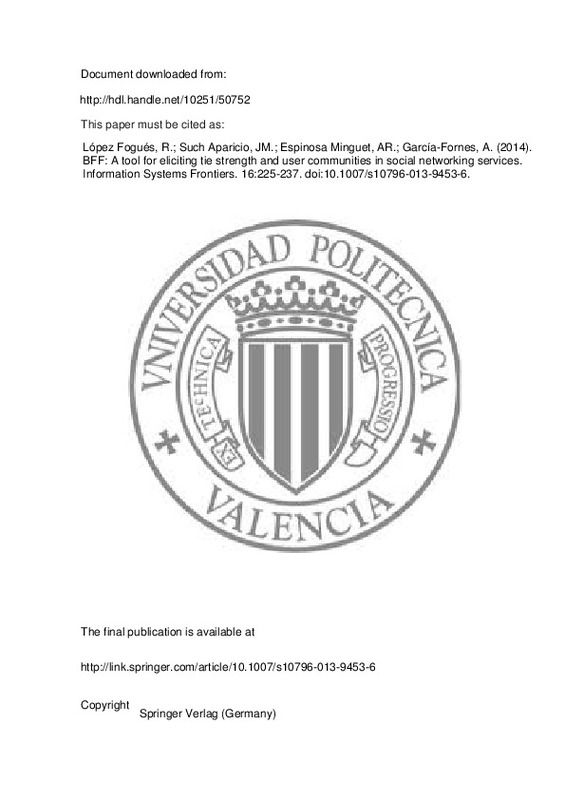Blondel, V.D., Guillaume, J.L., Lambiotte, R., Lefebvre, E. (2008). Fast unfolding of communities in large networks. Journal of Statistical Mechanics: Theory and Experiment, 2008(10), P10008.
Boyd, D., & Hargittai, E. (2010). Facebook privacy settings: who cares? First Monday, 15(8).
Burt, R. (1995). Structural holes: the social structure of competition. Harvard University Pr.
[+]
Blondel, V.D., Guillaume, J.L., Lambiotte, R., Lefebvre, E. (2008). Fast unfolding of communities in large networks. Journal of Statistical Mechanics: Theory and Experiment, 2008(10), P10008.
Boyd, D., & Hargittai, E. (2010). Facebook privacy settings: who cares? First Monday, 15(8).
Burt, R. (1995). Structural holes: the social structure of competition. Harvard University Pr.
Culotta, A., Bekkerman, R., McCallum, A. (2004). Extracting social networks and contact information from email and the web.
Ellison, N., Steinfield, C., Lampe, C. (2007). The benefits of facebook friends: social capital and college students use of online social network sites. Journal of Computer-Mediated Communication, 12(4), 1143–1168.
Fang, L., & LeFevre, K. (2010). Privacy wizards for social networking sites. In Proceedings of the 19th international conference on World wide web (pp. 351–360). ACM.
Fortunato, S. (2010). Community detection in graphs. Physics Reports, 486(3-5), 75–174.
Gilbert, E., & Karahalios, K. (2009). Predicting tie strength with social media. In Proceedings of the 27th international conference on human factors in computing systems (pp. 211–220). ACM.
Girvan, M., & Newman, M. (2002). Community structure in social and biological networks. Proceedings of the National Academy of Science, 99(12), 7821.
Granovetter, M. (1973). The strength of weak ties. American Journal of Sociology, 1360–1380.
Gross, R., & Acquisti, A. (2005). Information revelation and privacy in online social networks. In Proceedings of the 2005 ACM workshop on privacy in the electronic society (pp. 71–80). ACM.
Johnson, M., Egelman, S., Bellovin, S. (2012). Facebook and privacy: it’s complicated. In Proceedings of the eighth symposium on usable privacy and security (p. 9). ACM .
Kahanda, I., & Neville, J. (2009). Using transactional information to predict link strength in online social networks. In Proceedings of the third international conference on weblogs and social media (ICWSM).
Lancichinetti, A., & Fortunato, S. (2009). Community detection algorithms: a comparative analysis. Physical Review E, 80, 056–117.
Lancichinetti, A., Fortunato, S., Kertsz, J. (2009). Detecting the overlapping and hierarchical community structure in complex networks. New Journal of Physics, 11(3), 033–015.
Lin, N., Ensel, W., Vaughn, J. (1981). Social resources and strength of ties: Structural factors in occupational status attainment. American Sociological Review, 393–405.
Lipford, H., Besmer, A., Watson, J. (2008). Understanding privacy settings in facebook with an audience view. In Proceedings of the 1st conference on usability, psychology, and security (pp. 1–8). Berkeley: USENIX Association.
Liu, G., Wang, Y., Orgun, M. (2010). Optimal social trust path selection in complex social networks. In Proceedings of the 24th AAAI conference on artificial intelligence (pp. 139–1398). AAAI.
Matsuo, Y., Mori, J., Hamasaki, M., Nishimura, T., Takeda, H., Hasida, K., Ishizuka, M. (2007). Polyphonet: an advanced social network extraction system from the web. Web Semantics: Science, Services and Agents on the World Wide Web, 5(4), 262–278. World Wide Web Conference 2006 Semantic Web Track.
Murukannaiah, P., & Singh, M. (2011). Platys social: relating shared places and private social circles. Internet Computing IEEE, 99, 1–1.
Quercia, D., Lambiotte, R., Kosinski, M., Stillwell, D., Crowcroft, J. (2012). The personality of popular facebook users. In Proceedings of the ACM 2012 conference on computer supported cooperative work (CSCW’12).
Rosvall, M., & Bergstrom, C. (2008). Maps of random walks on complex networks reveal community structure. Proceedings of the National Academy of Sciences, 105(4), 1118–1123.
Sharma, G., Qiang, Y., Wenjun, S., Qi, L. (2013). Communication in virtual world: Second life and business opportunities. Information Systems Frontiers, 15(4), 677–694.
Shen, K., Song, L., Yang, X., Zhang, W. (2010). A hierarchical diffusion algorithm for community detection in social networks. In 2010 international conference on cyber-enabled distributed computing and knowledge discovery (CyberC) (pp. 276–283). IEEE.
Sierra, C., & Debenham, J. (2007). The LOGIC negotiation model. In AAMAS ’07: proceedings of the 6th international joint conference on autonomous agents and multiagent systems (pp. 1–8). ACM.
Staddon, J., Huffaker, D., Brown, L., Sedley, A. (2012). Are privacy concerns a turn-off?: engagement and privacy in social networks. In Proceedings of the eighth symposium on usable privacy and security (p. 10). ACM.
Strater, K., & Lipford, H.R. (2008). Strategies and struggles with privacy in an online social networking community. In Proceedings of the 22nd British HCI group annual conference on people and computers: culture, creativity, interaction, BCS-HCI ’08 (Vol. 1, pp. 111–119). Swinton: British Computer Society.
Wellman, B., & Wortley, S. (1990). Different strokes from different folks: Community ties and social support. American Journal of Sociology, 558–588.
Wiese, J., Kelley, P., Cranor, L., Dabbish, L., Hong, J., Zimmerman, J. (2011). Are you close with me? are you nearby? investigating social groups, closeness, and willingness to share. In Proceedings of the 13th international conference on Ubiquitous computing (pp. 197–206). ACM.
Xiang, R., Neville, J., Rogati, M. (2010). Modeling relationship strength in online social networks. In Proceedings of the 19th international conference on World wide web (pp. 981–990). ACM.
[-]







![[Cerrado]](/themes/UPV/images/candado.png)


